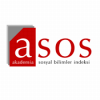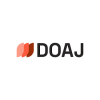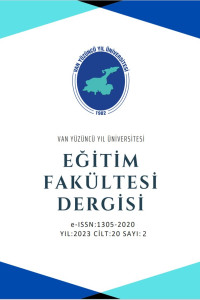Research Article
Aim & Scope
Van Yüzüncü Yıl University Journal of Education aims to contribute to a wide range of education fields from preschool education to higher education and adult education by establishing qualified links between theory and practice on a national and international perspective in the field.
Van Yüzüncü Yıl University Journal of Education includes articles in the field of education. In the articles, the criteria of being research-based, contributing to the field, offering suggestions for practice, examining new and different developments, and being up-to-date are taken into consideration.
Research articles (qualitative, quantitative and mixed methods) are published in either Turkish or English in Van Yüzüncü Yıl University Journal of Education.
Author Guidelines
Author Guidelines
Manuscripts should be organized in the following order, using the article template of our journal:
Title
Articles must have a title. Title; It should state the subject in the best way in Turkish and English, should not exceed fifteen words, and should be written in bold with the first letters capitalized.
Article Type
The article type should be written in bold under the title, in all capital letters.
Author Names and Addresses
Author names, titles, institutions, addresses, e-mail addresses and ORCID IDs should be indicated. Formatting in the template should be considered.
Abstract: The abstract of the study should not exceed 200 words. The abstract should be written in Times New Roman font, 11-point size, single line spacing, and justified.
It is important to mention the following points under the introduction title.
1) The focus of the study
2) Literature and theoretical framework discussions about the study
3) Why and for whom the subject discussed in the study is important
4) Possible contributions to the field
5) Points aimed in the study
6) Research question(s) or hypotheses tested
It is suggested that the points mentioned above be presented under titles such as "Theoretical Framework of Research", "Related Studies" and "Importance of Research/Study".
Under the method title, it is expected to be focused on the following points.
1) Presentation of the method used in the research (with reason)
2) Presenting the context of the research
3) Specifying the data collection methods used
4) Specifying the data collection tools used
5) Presenting the validity of the data collection tools and the reliability of the data
6) Target population, reachable population, specifying the sample or defining the study group.
7) Explanation of data analysis
8) Specifying the ethical points of the research. In studies that require ethics committee permission, information about the permission (name of the committee, date and number) can be presented in the method section and also on one of the first/last pages of the article; in case reports, information about signing the informed consent form should be included in the article.
Ethics Committee Permission Information: This research was conducted with the permission obtained with the decision of Van Yüzüncü Yıl University Social and Human Scientific Research and Publication Ethics Committee dated 15/01/22 and numbered 30112/11-07.
Conflict of Interest Information: There was no conflict of interest in this study and no financial support was received.
Author Contribution: The authors declare that they have contributed equally to the article.
Extended Summary (For Turkish Studies)
Please provide an extended summary, including the problem statement, method, findings, discussion, and conclusion. The extended summary should be within 800-1000 words (should not be less than 800 words).
Second Level Title
Second level headings should be left aligned, bold; only the first letters of the words should be capitalized and 12-point size. The paragraph after the title should start with an indent of 1.25 cm. There should be 6 pt space before the title and 6 pt after the title.
Third Level Title
Third-level headings should be left aligned, italicized, bold; only the first letters of the words should be capitalized and 12-point size. The paragraph after the title should start with an indent of 1.25 cm. There should be 6 pt space before the title and 6 pt after the title.
Fourth Level Title. Headings at this level should be indented 1.25 cm, the first letter of each word should be capitalized, bold and plain. There should be a dot at the end of the title. In this level of headings, the sentence should start on the same line as the heading line. There should be 6 pt space before the title and 6 pt after the title.
Fifth Level Title. This level heading should be italicized, indented 1.25 cm, and the first letter of each word should be capitalized and bold. A dot should be placed at the end of the title. In this level of headings, the sentence should start on the same line as the heading line. There should be 12 pt before the title and 6 pt after the title.
Table 1
Success Status by Socio-Economic Status
Continue by leaving a space of one line after the table.
Table 2
In-Text Citation Display Based On Author Type
Figure 1
Photo of Lake Van Becoming First in NASA's Contest
Continue by leaving a space of one line after the figure.
In-text reference
One Author (Halvorsen, 2018); Halvorsen (2018)
Two Authors (Allchin & Zemplen, 2020); Allchin and Zemplen (2020)
Three or more authors (Grangeat et al., 2021); Grangeat et al. (2021)
The publications used in meta-analysis, meta-synthesis, or review studies are presented with * in the reference list.
Articles
Allchin, D., & Zemplen, G. A. (2020). Finding the place of argumentation in science education: Epistemics and whole science. Science Education, 104(5), 907-933. https://doi.org/10.1002/sce.21589
*Grangeat, M., Harrison, C., & Dolin, J. (2021). Exploring assessment in STEM inquiry learning classrooms. International Journal of Science Education, 43(3), 345-361. https://doi.org/10.1080/09500693.2021.1903617
Halvorsen, K. (2018). Questions as interactional resource in team decision making. International Journal of Business Communication, 55(1), 69-93. https://doi.org/10.1177/2329488415589102
Books
Sidnell, J. (2010). Conversation analysis: An introduction. Wiley-Blackwell.
Şimşek, H., & Yıldırım, A. (2016). Qualitative research methods in the social sciences (10th ed.). Seçkin Yayıncılık.
Book Chapter
Roberts, A. D. (2007). Scientific literacy/science literacy. In S. K. Abell & N. G. Lederman (Eds.), Handbook of research on science education (pp. 729-780). Lawrence Erlbaum Associates.
Şardağ, M., Ecevit, T., Top, G., Kaya, G., & Çakmakcı, G. (2018). Science and engineering applications. In A. Tekbıyık & G. Çakmakcı (Eds.), STEM supported science teaching in accordance with current curriculum (pp. 239-264). Nobel Academic Publishing.
Conference Presentation
Craig, S. (2019, April 10–14). The cultural importance of obsidian in the upper Gila area [Poster presentation]. Society for American Archaeology, Albuquerque, NM, United States. https://www.archaeologysouthwest.org/free-resources/conference-posters/
Maddox, S., Hurling, J., Stewart, E., & Edwards, A. (2016, March 30–April 2). If mama ain't happy, nobody's happy: The effect of parental depression on mood dysregulation in children [Paper presentation]. Southeastern Psychological Association 62nd Annual Meeting, New Orleans, LA, United States.
Theses
Unpublished
Harris, L. (2014). Instructional leadership perceptions and practices of elementary school leaders [Unpublished doctoral dissertation]. University of Virginia.
Published
Hollander, M. M. (2017). Resistance to authority: Methodological innovations and new lessons from the Milgram experiment (Publication No. 10289373) [Doctoral dissertation, University of Wisconsin-Madison]. ProQuest Dissertations and Theses Global.
Documents Required During Application
Full text of the article without the author's name (in Word file format) (Anonymous file will be uploaded as "full text" when uploading the article files to the system)
Similarity report (complete report in PDF format)
Copyright Transfer Form
Ethics Committee Permission Document (Explanation file stating the reason if Ethics Committee Permission is not required)
Ethical Principles and Publication Policy
The publication processes implemented in the Van Yüzüncü Yıl University Journal of Education form the basis for the development and distribution of information in an impartial and respectable manner.
Peer-reviewed studies are studies that embody and support the scientific method. At this point, it is important that all stakeholders of the process (authors, readers and researchers, publisher, referees and editors) comply with the standards for ethical principles. Van Yüzüncü Yıl University Journal of Education is expected to bear all ethical responsibilities within the scope of publication ethics.
The author(s) are expected to answer the following questions in the context of Ethical Compliance.
If you have used unpublished tools, procedures or data that others may claim ownership of, have you obtained permission to use it?
Did you properly cite/cite published works that you have benefited from or cited in your article?
Data collection/application etc. in your work. Have you obtained the legal permissions for it?
Will you be able to answer questions from the editor about the "informed consent" of the people you collect data from or that you have made the necessary disclosures?
Have you taken adequate precautions to ensure the confidentiality of the information provided by participants, subjects, third parties, or those from whom you have obtained data, and to protect them from harm?
If there is more than one author, did all of the authors read and agree on the content?
If there is more than one author, did all authors agree on the order of author names?
If you have used copyrighted material, have you obtained permission to use these materials?
Editors' Responsibilities
Editors are responsible for every publication published in the Van Yüzüncü Yıl University Journal of Education. In the context of this responsibility, the editors;
Editors should make decisions by considering the knowledge, skills and experience expectations of all readers, researchers and practitioners. It should be careful that the published studies contribute to the reader, researcher, practitioner and scientific literature, and that they are original. In addition, editors are obliged to consider the feedback from readers, researchers and practitioners, and to provide explanatory and informative feedback.
Editors should make a positive or negative decision based on the importance, original value, validity, clarity of the narrative, and the journal's goals and objectives.
Studies that are suitable for the scope of publication should be taken to the preliminary evaluation stage unless they have serious problems.
Editors should not ignore positive referee suggestions unless there is a serious problem with the study.
The Blind Refereeing and Review Process must be published and the editors must prevent deviations from the defined processes.
Editors should publish an Author's Guide that includes in detail every subject expected of them by the authors. These guides should be updated periodically.
Authors should be informed and returned in an explanatory and informative way.
The referees should be determined in accordance with the subject of the study.
It is responsible for providing the information and guides that the referees will need during the evaluation phase.
It has to consider whether there is a conflict of interest between the authors and the referees and other editors.
In the context of blind arbitration, the identity of the referees should be kept confidential.
It should encourage the referees to evaluate the work in an impartial, scientific and objective language.
The referees should be evaluated with criteria such as timely return and performance.
Take the necessary steps to dynamically update the referee pool.
It should prevent rude and unscientific evaluations.
Take steps to ensure that the referee pool consists of a wide range.
Authors' Responsibilities
The author(s) who submit a candidate article to the journal of Van Yüzüncü Yıl University Journal of Education are expected to comply with the following ethical responsibilities:
The works submitted by the author(s) are expected to be original. If the author(s) benefit from or use other works, they are required to cite and/or cite completely and accurately.
Persons who do not contribute to the content intellectually in the creation of the work should not be specified as authors.
All the studies sent for publication should be explained, if any, situations that may constitute a conflict of interest and their relationships.
Raw data regarding their articles can be requested from the author(s) within the framework of the evaluation processes, in such a case the author(s) should be ready to present the expected data and information to the editorial board.
The author(s) must have a document showing that they have the right to use the data used, the necessary permissions for the research/analysis, or the consent of the experimental subjects.
In case the author(s) notices an error or mistake regarding his/her published, early view or evaluation stage work, he/she has the obligation to cooperate with the editor in informing, correcting or withdrawing the journal editor or publisher.
Referees' Responsibilities
Referees who are invited to be a referee by Van Yüzüncü Yıl University Journal of Education journal are expected to comply with the following ethical responsibilities:
First of all, the referees should only accept to evaluate the work related to their field of expertise.
The author(s) should not have access to their identity information. Should they reach or guess the author(s) identification information, they should terminate the review process.
Review should be done with impartiality and confidentiality.
If he thinks that he is facing a conflict of interest during the evaluation process, he should refuse to review the study and inform the journal editor.
They can use the studies they have reviewed only after the study is published. No information should be shared about a rejected study.
It should indicate related studies that are not cited.
It should make the evaluation objectively only in relation to the content of the study. Nationality, gender, religious beliefs, political beliefs and commercial concerns should not be allowed to influence the review.
Evaluation should be done in a constructive and kind language. They should not make derogatory personal comments that include slander and insult.
They should perform the work they accept to evaluate on time and with the above ethical responsibilities.
It has been prepared by considering the "COPE Code of Conduct and Best Practice Guidelines for Journal Editors" and "COPE Best Practice Guidelines for Journal Editors" published by the Committee on Publication Ethics (COPE) as open access while establishing ethical duties and responsibilities.
Ensuring the Accuracy of Scientific Information
Ethics in Reporting Research Results: The scientific method is based on the repeatability and verifiability of observations. Data may not be fabricated or altered to achieve a particular conclusion or support hypotheses, including by manipulating visual materials. Some of the data or findings cannot be ignored in order to obtain a more desirable and convincing result.
If there is an unintentional error in my writing, when the author realizes this error after the article is published, he has to announce this error to the readership. To do this, it notifies the editor and publisher of the error first and ensures that the correction is published. Each revision must be published on the web and accessible to readers.
Storage and Sharing of Data: When there are doubts about the accuracy of the research report, the author has to submit the data to the editor. If the author does not present the data, the article is rejected without further consideration. The researcher has to keep the data, application procedures and other materials for at least 5 (five) years from the date of publication of the research. After the article is published, other [qualified] researchers are required to share the data if they request research data. However, before sharing data with other researchers, all codes and data that could be associated with the identification of subjects/participants must be deleted. If research is funded by an institution, appropriate measures should be taken to protect the rights of that institution and to be cited appropriately. Between the researcher who wants to share the data and the researcher who owns the data; A written agreement must be signed and recorded, including the purpose of use of the data, scope of use, conditions and limitations, limits and conditions of sharing with third parties.
Publishing Data Again or Dividing in Parts: Republishing data is publishing the findings obtained from the same data in a second journal or another source as if they were being published for the first time. Republishing also results in violation of copyright laws. Because the author cannot give copyright to more than one institution for the same work. The whole of a previously published work or a part of it exceeding the amount that can be cited by citing the source cannot be published for the second time and in another source. A work with the same content or significantly similar to a previously published article cannot be submitted for consideration for publication. Manuscripts that have been presented as a paper but have not been published can be submitted for consideration in a journal by stating that it was presented as a paper with a footnote. However, published papers cannot be submitted for evaluation for publication in journals.
Plagiarism and Self-plagiarism: Authors cannot write other people's information and ideas as their own. Likewise, they cannot publish their previously published work or some of these works without attribution or citation.
Authorship: Authorship is a right earned by making a substantial contribution to a paper and accepting responsibility for the study published. To contribute significantly; means formulating the problem or hypothesis, structuring the experimental design or application procedures, performing statistical analysis, interpreting the results, writing part of the paper. Significant contributors are listed as authors. However, the names and contributions of other contributors that cannot be listed as authors should be indicated with footnotes. Other contributions that do not provide authorship rights but should be noted; It includes work and processes such as providing support in the creation of the data collection tool, making suggestions on data analysis techniques, collecting data or data entry, ensuring that the participants are found, and making routine observations.
While listing the names of the authors, the names of the authors are listed, starting with the author who contributed the most, taking into account the contribution of each author in general. If the contributions of the authors are equal, this issue can be clearly stated and alphabetical order can be made. Institutional or professional titles and statuses are not taken into account when naming authors.
Intellectual Property Rights Protection
Quotations and references should be made according to Article 35 of the Law No. 5846 on the Protection of Intellectual and Artistic Works (and Law No. 4630 amending this Law). According to Law No. 4630, the legal framework of citation or citation is defined as follows:
"Article 35 - It is permissible to cite a work in the following cases:
Taking some sentences and anecdotes of a publicized work into an independent work of science and literature;
Incorporating the most themes, motifs, passages and ideas of a published composition into an independent musical work;
Putting the works of fine art and other published works, which have become public, in a scientific work, in a proportion justified by the purpose, in order to illuminate their content;
Showing the works of fine art, which have become public, in scientific conferences or lectures, by means of projection and similar means to illuminate the subject.
The quotation must be made in a clear way. In scientific works, besides the name of the work used in the citation and the name of the owner of the work, the place where this part is taken is indicated.
Going beyond the citation and reference limits specified in this article constitutes a crime, and the penalties to be applied in case of committing this crime are also regulated by article 71 of Law No. 4630:
"Article 71 - (Amended article: 01/11/1983 -2936/11.; Amended article: 23/01/2008-5728 S.K./138.) Spiritual, financial and financial works related to intellectual and artistic works taken under protection in this Law or in violation of related rights:
Offering a work, performance, phonogram or production of works that are processed, represented, reproduced, modified, distributed, transmitted to the public by means of any sign, sound or image transmission, published or illegally processed or reproduced without the written consent of the right holders. A person who sells, distributes by leasing or lending or in other ways, buys for commercial purposes, imports or exports, holds or stores for purposes other than personal use, is sentenced to imprisonment from one year to five years or a judicial fine.
The person who names the work of another person as his own work is punished with imprisonment from six months to two years or a judicial fine. If this act is committed by distribution or publication, the upper limit of the prison sentence is five years and a judicial fine cannot be imposed.
The person quoting a work without citing the source is punished with imprisonment from six months to two years or a judicial fine.
A person who makes a public statement about the content of a work that has not been made public, without the permission of the right holders, is punished with imprisonment up to six months.
A person who provides insufficient, false or deceptive references for a work is punished with imprisonment up to six months.
A person who reproduces, distributes, disseminates or publishes a work, performance, phonogram or production using the name of another well-known person is punished with imprisonment from three months to one year or a judicial fine. Those who commit the acts mentioned in the first paragraph of additional article 4 of this Law without authorization and information content providers who continue to violate the rights recognized in this Law, are sentenced to imprisonment from three months to two years, unless their acts constitute a crime requiring a heavier penalty.
If a person who offers, sells or buys a work, performance, phonogram or production that has been produced, processed, reproduced, distributed or published illegally, ensures that they are caught by informing from whom they obtained them before the prosecution phase, the penalty to be imposed may be reduced or the penalty to be imposed may be reduced. can also be waived."
If You Encounter an Unethical Situation
If you encounter any unethical behavior or content in the Journal of Van Yüzüncü Yıl University Journal of Education, please immediately report it to efdyyu@hotmail.com or ramazansak@yyu.edu.tr via e-mail.
Price Policy
Charge Policy
Van Yüzüncü Yıl University Journal of Education provides applications, reviews, evaluations, readings, publications, etc., with the understanding that making research publicly available supports global information exchange. It does not charge any fee.
Submitting articles to the journal and publishing the accepted articles in the review process is completely free.
Indexes
Citation Indexes
Other Indexes
Journal Boards
The Dean of the Faculty of Education
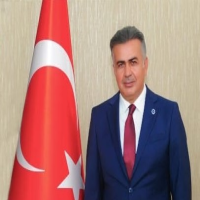
Editor in Chief

Assistant Editor

Editorial Board
Dr Laetitia Coles is a Research Fellow within the Science of Learning Lab at the Queensland Brain Institute, led by Laureate Prof Karen Thorpe. As a mixed-methods applied sociologist, she leads the Workforces component of the Thriving Queensland Kids Brain Builders Initiative (https://qbi.uq.edu.au/brain-builders) in support of the generation, translation, and application of knowledge from neurosciences into policy and practice, as well as leading the award-winning project entitled Families in Focus: Amplifying the voices of children with disability and their families (https://child-health-research.centre.uq.edu.au/event/5632/families-focus), in collaboration with Queensland Children's Hospital. She is committed to undertaking research that helps improve understandings of children’s care environments, with a specific focus on supporting those who care for and educate children. Dr Coles’ experience in multi-disciplinary research and in industry engagement underpins her strong track record in knowledge and research translation through both traditional and non-traditional research outputs.
Dr Coles completed her PhD in Sociology in 2020, looking at long work hours and fathers' engagement with children and caregiving – particularly focusing on the factors that facilitate participation in caregiving.


Mehmet Şen 1987 yılında Ankara’da doğdu. 2011 yılında ODTÜ Fen Bilgisi Öğretmenliği Bölümü’nden mezun oldu. Aynı yıl ODTÜ Matematik ve Fen Eğitimi Bölümünde yüksek lisansa başladı. 2012 yılında ODTÜ İlköğretim Bölümünde araştırma görevlisi oldu ve 2014 yılında deneyimli fen bilgisi öğretmenlerinin hücre bölünmesi konusunda pedagojik alan bilgilerini incelediği yüksek lisans tezini tamamladı. 2014 yılında İlköğretim Bölümü’nde başladığı doktora eğitimini 2021 yılında tamamladı. Doktora tezi sürecinde ortaokul öğrencilerinin fen derslerinde argümantasyon sürecine katılımlarını, kullandıkları argümantasyon şemalarını ve argümantasyon eğitiminin bilimsel okuryazarlık düzeyine etkisini gerçek sınıf ortamında araştırdı. Araştırma görevlisi olduğu süre zarfında fen eğitiminde öğretim yöntemleri, laboratuvar uygulamaları, okul uygulamaları, istatistik, ölçme ve değerlendirme, araştırma yöntemleri dersleri başta olmak üzere birçok derste görev aldı.
Araştırma Alanları:
İçerik alan bilgisi ile pedagojik alan bilgisinin ilişkisi,
Bağlam bilgisi ile pedagojik alan bilgisinin ilişkisi,
Bilimsel bilginin doğası ve argümantasyon,
Argümantasyonun fen okuryazarlığına etkisi,
Temel ve türetilmiş fen okuryazarlığı
Eğitim Derecesi:
PhD, Orta Doğu Teknik Üniversitesi (İlköğretim)
MSc, Orta Doğu Teknik Üniversitesi (Matematik ve Fen Bilimleri Eğitimi)
BSc, Orta Doğu Teknik Üniversitesi (Fen Eğitimi)

Doç. Dr. Sinan KESKİN, 2010 yılında Gazi Üniversitesi Teknik Eğitim Fakültesi Bilgisayar Sistemleri Bölümü'nden mezun olmuştur. Lisansüstü eğitimini Öğretim Teknolojileri alanında Hacettepe Üniversitesi'nde tamamlayarak 2019 yılında doktor unvanını almış ve 2023 yılında ilgili alanda doçentlik unvanına hak kazanmıştır. Hacettepe Üniversitesi ve Van Yüzüncü Yıl Üniversitesi'nde görev yapan Keskin, 2022-2025 yılları arasında Cumhurbaşkanlığı İnsan Kaynakları Ofisi, Ölçme ve Değerleme Dairesi Başkanlığı’nda görev yapmıştır. Bu süre zarfında İş Analizi Projesi ve Ulusal Staj Programı kapsamındaki ölçme ve değerlendirme süreçlerinde aktif rol almıştır.
Akademik ilgi alanları arasında uzaktan eğitim, e-değerlendirme, geribildirim tasarımı, öğretimsel tartışmalar, ölçme aracı tasarımı, öğrenme analitikleri ve veri madenciliği bulunmaktadır.







Dr. Mustafa Gök, şu anda Van Yüzüncü Yıl Üniversitesi Eğitim Fakültesi, Matematik ve Fen Bilimleri Eğitimi Bölümü'nde Doktor Öğretim Üyesi olarak görev yapmaktadır. 2018 yılında Anadolu Üniversitesi'nde Matematik Eğitimi alanında bütünleşik doktora programını tamamlamış ve tezinde, matematik öğretim programlarının didaktik ve ekolojik yönlerine odaklanarak öğretmenlerin fonksiyon kavramına ilişkin prakseolojilerini incelemiştir.
Araştırma alanları arasında matematiksel modelleme, matematik eğitiminde dijital oyun tabanlı öğrenme ve öğretmenlerin pedagojik alan bilgisi geliştirme süreçleri yer almaktadır. Diskalkuli, matematiksel modelleme ve STEM eğitimi üzerine yürütülen birçok yüksek lisans tezine danışmanlık yaparak bu alanlarda önemli katkılarda bulunmuştur.
Ulusal ve uluslararası dergilerde geniş bir yelpazede makaleler yayımlayan Dr. Gök, matematiksel kavramların anlaşılmasını geliştirmek amacıyla mobil oyunların kullanımını içeren yenilikçi öğretim yöntemlerine odaklanmaktadır. Son dönem araştırma projeleri arasında oyun tabanlı öğrenmenin öğrencilerin uzamsal yetenekleri ve problem çözme becerileri üzerindeki etkisini incelemek yer almaktadır.




http://nadidem.net/nasip/ingindex.htm

Dr. Sharolyn Pollard-Durodola, EdD is a Professor in the English Language Learning program in the Department of Early Childhood, Multilingual, and Special Education, in the College of Education at the University of Nevada Las Vegas. A recipient of a Fulbright Nehru Academic and Professional Excellence Award (Primary Grade Multilingualism in India thru a Historical Ethnographic Lens), her scholarship attends to the language and literacy development of multilingual students and the intersection of educator beliefs with language education policies. Central to her scholarship is developing school-based interventions, evaluating their impact on the language and conceptual knowledge development of PK-3 multilingual learners and investigating how to improve the quality of academic language practices that are embedded in content area instruction (e.g., science, social studies, mathematics, English language arts). She has been the co-principal investigator on two IES grants titled Words of Oral Reading and Language Development (WORLD), focusing on preschool language/literacy development and was the co-principal investigator for Project E3: Enhancing, Engaging, and Empowering Teachers for the Next Generation of English Learners funded by The Office of English Language Acquisition (OELA), National Professional Development Program. She was also the Senior Researcher (Nevada) for the multi-site Project International Consortium for Multilingual Excellence in Education (ICMEE), also a National Professional Development Grant funded by OELA. These OELA grants focused on supporting the instructional practices of general education teachers of multilingual learners with attention to the influence of teacher beliefs and attitudes on their pedagogical practices.
DR. JEAN-YVES PLAISIR
Email · jean.plaisir@bestcarecollege.edu
For the past 10 years, I have been involved in national, international, and intercultural research projects focusing on men's involvement in the early childhood education workforce. My research focuses narrowly on gender balance and diversity in the workforce and higher education systems. I endeavor to use empirical research evidence to gauge policy and inform practice about social justice, equity, and inclusion in the workforce and education systems.
EXPERIENCE
03/22-PRESENT
CONSULTANT / DIRECTOR OF CORPORATE COMPLIANCE
Assist the College Director, Program Directors, faculty, and department representatives to review and address college concerns; review policies of BCC for compliance with regulatory and accrediting bodies; respond to inquiries from regulatory and accrediting bodies; assist with the preparation of reports for accrediting bodies and legal entities; address concerns regarding Best Care College's policies; assist with orientation and ongoing education of faculty to regulatory requirements and BCC's policies; assist the Program Directors with the evaluation of curricula and attend curriculum committee meetings as scheduled; conduct ongoing reviews to help maintain consistency of BCC's documents, handbooks, and Website; assess and conduct record audits for completeness; appraise survey and other data collection relative to the Systematic Plan of Evaluation; review regulatory and accrediting body Websites to identify changes in regulations and accreditation guidelines.
09/20 – PRESENT
LANGUAGE & COMMUNICATION COACH, BEST CARE COLLEGE
Teaching, mentoring, and supporting nursing students to develop and hone skills in public speaking, writing, and intercultural communication; have been successful in motivating students to work hard and take risks.
09/98 – PRESENT
PROFESSOR, CITY UNIVERSITY OF NEW YORK
Developing, teaching, and improving teacher education curricula; has maintained a successful track record in teaching, research, and service in the teaching profession.
EDUCATION
DOCTOR OF EDUCATION, TEACHERS COLLEGE, COLUMBIA UNIVERSITY
Major: Applied Linguistics
MASTER OF ARTS, TEACHERS COLLEGE, COLUMBIA UNIVERSITY
Major: Teaching English to Speakers of Other Languages (TESOL)
MASTER OF EDUCATION, TEACHERS COLLEGE, COLUMBIA UNIVERSITY
Major: International Educational Development
BACHELOR OF ARTS, HUNTER COLLEGE, CITY UNIVERSITY OF NEW YORK
Major: Classical Studies
SKILLS
• Proven experience in the use of mixed research methods (qualitative and quantitative);
• Experienced in institutional strategic planning; • Strong classroom-based research skills;
• Well-versed in language education and intercultural communication.
ACTIVITIES
Integrated technology in classroom instruction; developed eLearning courses and online support for students; designed and applied outcome-based assessment measures in teaching and learning; experienced with various technology platforms, including DegreeWorks, BlackBoard, Pageout, Zoom, and Webex; implemented teaching and learning methodologies to improve student learning outcomes; knowledgeable about evaluation systems and academic planning strategies.
SELECTED PUBLICATIONS
Rohrmann, T.; Brody, D.; Plaisir, J. Y. (2020). A diversity of cultural and institutional contexts. In David L. Brody, Kari Emilsen, Tim Rohrmann, Jo Warin (eds), Exploring Career Trajectories in the Early Childhood Education and Care Workforce: Why They Leave and Why They Stay (pp. 28-40). London and New York: Routledge.
Plaisir, J. Y.; Thordardottir, T.; Xu, Y. (2020). Societal factors impacting men's turnover in ECEC. In David L. Brody, Kari Emilsen, Tim Rohrmann, Jo Warin (eds), Exploring Career Trajectories in the Early Childhood Education and Care Workforce: Why They Leave and Why They Stay (pp. 98-110). London and New York: Routledge.
Emilsen, K.; Plaisir, J. Y. ; Sak, R. ; Eidevald, C. (2020). Why Men Stay. In David L. Brody, Kari Emilsen, Tim Rohrmann, Jo Warin (eds), Exploring Career Trajectories in the Early Childhood Education and Care Workforce: Why They Leave and Why They Stay (pp. 153-164). London and New York: Routledge.
Reich-Shapiro, M.; Cole, K.; Plaisir, J. Y. (2020). "I Am the Teacher": How Male Educators Conceptualize their Impact on the Early Childhood Classroom. Journal of Early Childhood Teacher Education, DOI: 10.1080/10901027.2020.1754310
Plaisir, J. Y., Cole, K., & Reich-Shapiro, M. (2019). Examining Intrinsic and Extrinsic Factors Impacting Men's Decisions to Teach Young Children. Published Research Report: Borough of Manhattan Community College. DOI: https://www.bmcc.cuny.edu/wpcontent/uploads/2019/10/BMCCPlaisiretalExecutiveSummary2019.pdf
Cole, K., Plaisir, J.Y., Reich-Shapiro, M., Freitas, A. (2019). Building a Gender-balanced Workforce: Supporting Male Teachers. Young Children, Vol 74, No. 4. DOI: https://www.naeyc.org/resources/pubs/yc/sept2019/building-gender-balanced- workforce-supporting-male-teachers
Cole, K., Reich-Shapiro, M., Siganporia, T., Tan de Bibiana, J. & Plaisir, J. (2019). 'Why not become a police officer?' Challenges in the recruitment and retention of men in early childhood education. In Rinke, C. & Mawhinney, L., Opportunities and Challenges in Teacher Recruitment and Retention (Vol. 2, Contemporary Perspectives on the Lives of Teachers). Charlotte, NC: Information Age Publishers.
Op-Ed
Kirsten Cole, Jean-Yves Plaisir, Mindi Reich-Shapiro. How can we get more men in early childhood education? New York Daily News, January 30, 2020 https://www.nydaily.
news.com/opinion/ny-oped-men-early-childhood-education-20200130-rhva6yna5fh3ncj6gwy7lx4szu-story.html Jackie Mader. What is it like to be a male teacher in early ed? The Hechinger Report, November 28, 2019.MEMBERSHIP
TO PROFESSIONAL ORGANIZATIONS
2020-Present Member, Society for Research in Child Development
2020-Present Member, Black Caucus, Society for Research in Child Development
2019-Present Member, New York City Early Childhood Education Research Network
2018-Present Member, American Educators Research Association
2010-Present Member, Haitian Studies Association
REFERENCES
References will be furnished upon request.
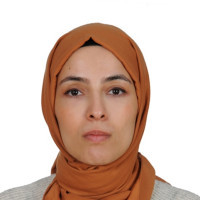

Buad Khales Professor in Curriculum & Early childhood, Educational Sciences, Director of Child Institute. AlQuds University. Email: bkhales@staff.alquds.edu
Buad an educational counselor, she work as consultant in developing strategic plan with Ministry of education- Palestine, consultant in professional standards for early childhood teacher education, with ministry of education – Palestine and consultant in Alrrowad company Saudi Arabia in early childhood program (training and training kit).
Buad Publisher 40 papers focused on child- centered teaching, Reflective teaching, Portfolio, inquiry, and new teaching methods in early childhood education , she Published Chapter in Book . also, she leads the team to Study on the Quality and Access of Early Childhood Education – with a focus on Preschools institutions – in the Occupied Palestinian Territories, Submitted to Save the children, Buad Supervised master thesis in early childhood. She offered educational counseling for different organizations (Aleman childhood center, Alrowad company, Ministry of Education, Bawaker society)


Dr. Marey-Sarwan Ibtisam is chair of the Early Childhood department and a senior lecturer at Sakhnin College and the Hebrew University of Jerusalem. She has vast experience studying culture and risk among parents, children, and professionals, with expertise in child maltreatment and child neglect, using various qualitative techniques. Her research focuses on multiculturalism and socio-cultural-political contexts and is grounded in ecological and critical theory, context-informed research, hybridity, and power relations. Coming from the field of education, she brings a vital connection to the teachers' discourse.
Secretariat









